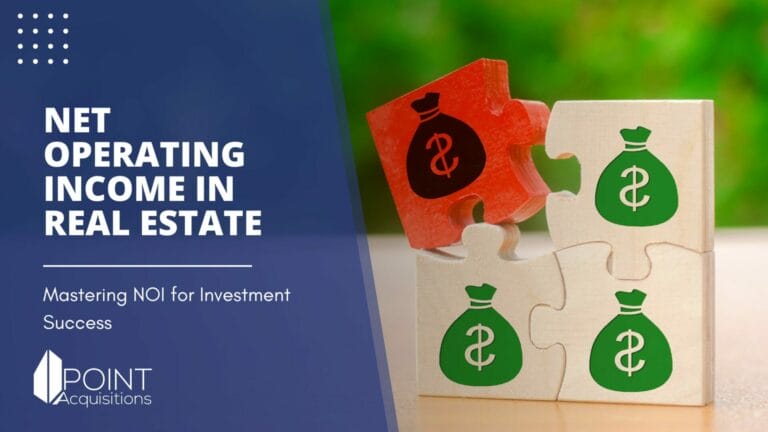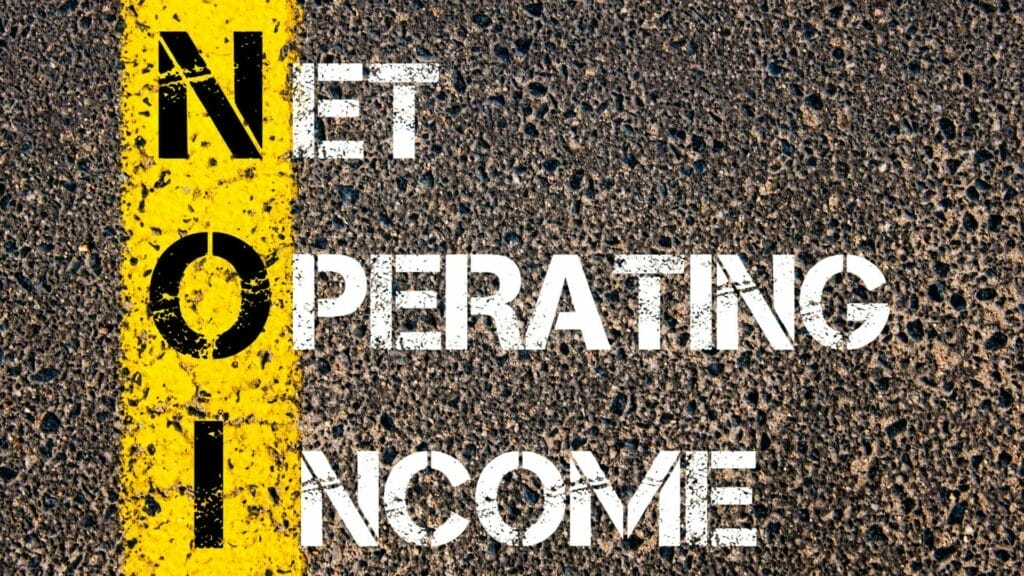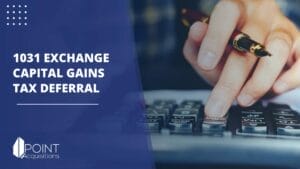
What is NOI: A Guide to Mastering Net Operating Income in Real Estate
The pulse of a property’s economic health in real estate is Net Operating Income (NOI). What is NOI? Calculating NOI simply involves subtracting operating expenses from generated income, excluding major one-time costs. It’s a clear-cut figure key for investors to evaluate property performance and make informed decisions.
This piece will unravel the complexities of NOI, stripping away the jargon and providing you with the essential knowledge needed to confidently deal with the real estate landscape.

Table of Contents
Defining NOI: Net Operating Income in Real Estate
Net Operating Income, or NOI, is an essential metric in real estate investing. It evaluates the profitability of income-generating properties. NOI is a calculation of all revenue generated from a property, including rents and other income streams, subtracted by all essential operating expenses necessary for the property’s operation and maintenance. To calculate net operating income, you simply need to follow this formula. This means that NOI offers valuable insights into the financial performance of real estate investments, including a property’s net operating income.
Keep in mind, not all expenses are factored into the NOI calculation. Major one-time costs like large capital expenditures, depreciation, and amortization are excluded because they do not contribute to measuring the property’s operating income. This exclusion allows NOI to focus on the fundamental purpose of assessing a property’s operational success.
The role of NOI in real estate investing
Essentially, NOI serves as a standardized indicator of profitability, encouraging more informed investment decision-making. It provides a precise measure of the property’s operational efficiency, essential for identifying areas needing attention or improvement.
Furthermore, NOI contributes to comparing investment opportunities by providing a consistent metric for assessing different properties’ profitability and potential return. Put differently, NOI can guide investors in identifying properties with potentially higher returns over time. This makes NOI an indispensable tool for informed decision-making, focusing on the continuous operational success of income-generating properties.
Factors influencing NOI
A full understanding of NOI also requires an awareness of its key influences. Factors such as:
- Property Location
- Size
- Type
- Rental rates
- Operating expenses
all play a role in shaping NOI. For instance, the location of a property can significantly affect its NOI as it influences the property’s tenant attraction, rental rates, and overall market value — all crucial elements in the NOI calculation.
Therefore, these factors must be taken into account when analyzing NOI to understand their potential impact on a property’s profitability. This way, investors can gain a more complete view of a property’s performance and make more informed investment decisions.

Calculating NOI: Breaking Down the Formula
After understanding what NOI is and its influencing factors, you need to learn how it is calculated. The NOI formula includes the fundamental operational performance of a real estate asset, capturing its core profitability by deducting operating expenses from gross operating income.
But what exactly are these operating expenses? They include all direct expenditures related to the operation of the property, including the property’s operating expenses, such as:
- Maintenance
- Management fees
- Utilities
- Insurance
- Property taxes
Remember, certain items like depreciation, interest, income taxes, and capital expenditures are not included in the NOI calculation since they are deemed external to the operations and profitability at the property level.
Gross Operating Income
In the NOI calculation, Gross Operating Income is a crucial component. It includes all revenue generated by a property, including:
- Rent received from tenants
- Earnings from leasing parking spaces
- Earnings from leasing storage areas
- Earnings from on-site vending machines
- Earnings from laundry services
This means all these income streams contributing to the cash flow are considered part of the total revenue.
Hence, it is crucial to take into account all possible income sources while calculating NOI. By doing so, you can get a more accurate picture of a property’s revenue generation potential and its impact on NOI.
Operating Expenses
On the other side of the NOI equation are operating expenses. These include expenditures related to the management and upkeep of a property in the following forms:
- Taxes
- Insurance
- Maintenance
- Insurance premiums
- Property management fees
- Repairs
These are all part of the operating expenses considered in the NOI calculation.
Other costs such as:
- marketing and advertising
- leasing
- property management
- property taxes
are also included. Therefore, all these costs must be considered when calculating NOI to accurately represent a property’s net income.

NOI vs. Other Financial Metrics
While NOI is a fundamental metric in real estate investing, it isn’t the only financial metric to which investors should pay heed. Other metrics like cap rate and the Debt Service Coverage Ratio (DSCR) also play significant roles in evaluating property investments.
While NOI represents the disparity between a property’s income and expenses, the cap rate is the rate of return derived from dividing the NOI by the total cost of the property. Similarly, the DSCR is determined by dividing the NOI by the total debt service, which includes both principal and interest. These metrics, when analyzed alongside NOI, can provide a clearer picture of a property’s financial performance and potential return on investment.
NOI and Cap Rate
Investors frequently compare the cap rate with NOI, another key financial metric. As mentioned earlier, Cap Rate is a quantitative measure used in real estate to assess a property’s potential return on investment. It is calculated by dividing the property’s Net Operating Income (NOI) by its purchase price or current market value.
For instance, a property with a listed price of $1,000,000 and an NOI of $50,000 would yield a cap rate of 5%. This allows investors to compare the returns of different properties, making it a useful tool for evaluating investment potential across diverse market conditions and property types. In this way, NOI and cap rate work hand in hand to provide a comprehensive picture of a property’s potential return on investment.
NOI and Debt Service Coverage Ratio (DSCR)
Investors also consider the Debt Service Coverage Ratio (DSCR) as another significant metric alongside NOI. This ratio is determined by dividing the net operating income by the total debt service, which includes both principal and interest.
A DSCR value above 1 indicates that the property is producing enough operating income to adequately cover its debt service expenses. This can provide a sense of security for lenders and investors, signifying that the property has a cushion and potentially reducing risk. Therefore, analyzing NOI together with DSCR can provide investors with a more well-rounded view of a property’s financial performance and debt service capacity.

Maximizing NOI: Strategies for Enhancing Property Profitability
After understanding what NOI is and its calculation method, investors should then look into strategies for maximizing NOI. This can be achieved by maximizing rental income and reducing operating expenses, ultimately leading to increased property profitability.
Whether you are an experienced real estate investor or a beginner aiming for your first real estate investment, knowing how to maximize NOI can provide a competitive advantage. It allows you to extract the most value from your investment, making sure that your property remains profitable in the long term.
Boosting Rental Income
One of the primary strategies for maximizing NOI in a rental property involves increasing rental income. This can be achieved through:
- regular rent increases
- improving property amenities
- attracting high-quality tenants
Regular rent adjustments help make sure that your rental income remains competitive with the market, while improved amenities can increase the appeal of your property and potentially result in increased rental income. Attracting high-quality tenants can also lead to higher and more consistent rental income, contributing to a higher NOI and, ultimately, a more profitable investment.
Reducing Operating Expenses
Conversely, curbing operating expenses is another potent strategy for bolstering NOI. This can be accomplished by implementing cost-saving measures, optimizing property management, and using technology to streamline operations.
Cost-saving measures could include negotiating improved rates for services, finding more efficient ways to conduct maintenance and repairs, or allocating resources to cost-effective marketing strategies. Meanwhile, optimizing property management can improve the efficiency of property operations, improve tenant relations to minimize turnover, and manage resources more effectively to prevent wastage. Using technology can also significantly save operating expenses by automating tasks, improving communication, and providing better data for decision-making.
Analyzing NOI: Using NOI to Evaluate Investment Opportunities
With a solid understanding of NOI and strategies to maximize it, investors can employ this knowledge to assess investment opportunities. Analyzing NOI can help investors assess property performance and compare investment opportunities with varying NOI levels.
This ability to analyze and compare properties based on NOI can be incredibly valuable for investors. It allows for a standardized comparison of properties, regardless of their size or location, providing a clear indication of their financial performance and potential return on investment.
Assessing Property Performance
Evaluating property performance with NOI forms a vital part of the investment process. NOI serves as a foundational tool for assessing potential returns on investment, evaluating profitability, and making informed decisions within the real estate sector.
Through NOI, investors can:
- Evaluate a property’s profitability
- Forecast future cash flows
- Evaluate its potential return on investment (ROI)
- Determine the property’s value
- Conduct a comparative analysis with other properties
This makes NOI an invaluable tool in assessing the performance of a property and informing investment decisions.
Comparing Properties with Different NOI Levels
Another significant component of investment analysis is the comparison of properties with varying levels of NOI. By comparing the NOI levels of various properties, investors can determine which properties offer the best potential return on investment and align with their risk tolerance.
For instance, investors with a higher risk tolerance may find it more acceptable to invest in properties with lower NOI levels, as they may perceive the potential for greater future returns. Conversely, investors with a lower risk tolerance may favor properties with higher NOI levels due to their stability and reliable income.
Therefore, understanding and comparing NOI levels can help investors find properties that best fit their investment strategies and risk profiles.

Common NOI Misconceptions and Pitfalls
Despite its significance, investors should be aware of several common misconceptions and pitfalls associated with NOI. These include:
- The misconception that NOI solely represents the property’s market value
- The belief that maintaining high occupancy is essential for maximizing profit
- The oversight of considering all operating expenses such as insurance and property tax.
Being aware of these misconceptions and pitfalls can help investors avoid costly mistakes and make more informed decisions. By understanding what NOI truly represents and how it should be calculated, investors can avoid these pitfalls and better leverage NOI to their advantage.
NOI vs. Net Income
One common misconception is that NOI is equivalent to net income. However, the truth is that these two metrics are quite different. While NOI is calculated by deducting all operating expenses from revenue, net income is derived by deducting all expenses, including both operating and non-operating expenses, from revenue.
For example, non-operating expenses that are part of net income but not included in NOI include:
- interest expense (such as interest payments on debt)
- restructuring costs
- inventory write-offs
- payments to settle lawsuits
- financing costs (such as mortgage interest or loan fees)
- income taxes
- property depreciation
Understanding these two metrics’ differences can help investors make more accurate and informed investment decisions.
Limitations of NOI
While NOI serves as an invaluable tool for real estate investors, it does have its limitations. For instance, NOI doesn’t account for financing costs, market trends, and investment risks. This means that NOI alone may not provide a complete picture of a property’s financial performance or potential return on investment.
For example, changes that may impact rental rates or occupancy levels, such as market trends, are not considered in the NOI calculation. Furthermore, NOI does not account for various types of investment risks, such as those related to:
- unfavorable locations
- adverse cash flows
- high vacancy rates
- troublesome tenants
- valuation risk
- lack of liquidity
Therefore, while NOI is an important metric to consider, it should be analyzed alongside other financial metrics to provide a more comprehensive view of a property’s investment potential.
What is noi Summary
In conclusion, understanding and mastering Net Operating Income (NOI) is crucial for success in real estate investing. From defining NOI and breaking down its formula to comparing it with other financial metrics and exploring strategies to maximize it, we have equipped you with the knowledge you need to leverage NOI in your real estate investments.
Now, it’s up to you to apply this knowledge and use NOI to unlock new investment opportunities, assess property performance, and, ultimately, achieve your investment goals.

Frequently Asked Questions
What is the NOI on a rental property?
The NOI on a rental property, also known as net operating income, is calculated by subtracting the property’s operating expenses from the income it generates. It is a key valuation method used in real estate to determine profitability.
Is NOI the same as net income?
NOI does not equate to net income. Net operating income (NOI) only accounts for expenses directly related to property operations, while net income includes all expenses, as well as capital gains/losses and extraordinary items.
Is Noi monthly or yearly?
NOI is typically calculated on an annual basis, not monthly.
How can I maximize NOI for my property?
To maximize NOI for your property, focus on increasing rental income and reducing operating expenses to enhance overall profitability.
What are some limitations of NOI?
NOI is a valuable tool for real estate investors, but it does not consider financing costs, market trends, and investment risks. It is essential to analyze it alongside other financial metrics for a comprehensive view of a property’s investment potential.
About The Author

Jesse Shemesh
Disclaimer
Please note that Point Acquisitions is not a tax expert or tax advisor. The information on our blogs and pages is for general informational purposes only and should not be relied upon as legal, tax, or accounting advice. Any information provided does not constitute professional advice or create an attorney-client or any other professional relationship. We recommend that you consult with your tax advisor or seek professional advice before making any decisions based on the information provided on our blogs and pages. Point Acquisitions is not responsible for any actions taken based on the information provided on our blogs and pages.
1031 Exchange Capital Gains Tax Deferral
According to a 2021 report by the National Real Estate Exchange Services (RES), over 240,000 1031 exchange transactions were completed in the United States, totaling $100 billion. This impressive figure underscores the role of 1031 exchanges in the real estate…
Read More1031 Exchange Benefits
As of Q4 2023, the national vacancy rate for all commercial property types in the United States sat at 9.2%, according to CBRE’s latest insights and research. This represents a slight decrease compared to the previous quarter and suggests a…
Read More1031 Exchange Legal Considerations: A Must-Read Guide
You’re in the right place if you’re considering a 1031 exchange for your commercial real estate investments. Whether you’re a seasoned investor or just dipping your toes into the market, understanding the legal landscape of 1031 exchanges is key to…
Read More

